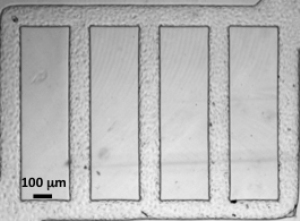The vascular system, which is essentially a network of arteries carrying blood and nutrients in the human body, is integral to the functioning of the tissues in any part of the body. But these blood vessels are difficult to introduce into synthetic tissue used for regenerative treatment such as tissue replacement procedures.
 An optical micrograph of an endothelialized microfluidic network. Cells are visible as graininess along channels.
An optical micrograph of an endothelialized microfluidic network. Cells are visible as graininess along channels.
Engineers led by Associate Professor, Abe Stroock, at Cornell University have synthesized blood vessels that do not pose such a problem. The engineers have used a soft biomaterial to produce tiny three dimensional microchannels. They injected endothelial cells from the human umbilical vein into the channels. The engineers then implanted tissue cells from the brain in the area around the channels. The signals produced by the surrounding cells led to the generation of new blood vessels from the endothelium cells in the channels. The engineers eventually hope to let the cells develop into a fully operating vascular system.
This successful in vitro generation of blood vessels is heralded as a significant step towards charting new techniques of regenerative surgery and drug delivery. They could facilitate the development of human tissues for the purpose of laboratory studies as well as for tissue replacement in surgeries. The engineers also carried out experiments in collaboration with Claudia Fischbach-Teschl, Associate Professor of biomedical engineering, to study the growth of tumors by replicating diseases such as cancer and thrombosis in the synthetic channels by injecting certain proteins which caused vessel growth and inflammation similar to cancer infected cells.
The research is funded by a host of organizations such as the Human Frontiers in Science Programme, the New York State Division of Science, Technology and Innovation, National Institutes of Health and the Arnold and Mabel Beckman Foundation.
Professor Stroock stated that the team was attempting to understand the influence of the physical environment on the growth of the blood vessels from a single grid in the placenta to an intricate network through their work.